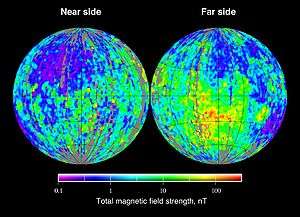Magnetic field of the Moon
The magnetic field of the Moon is very weak in comparison to that of the Earth; the major difference is the Moon does not have a dipolar magnetic field currently (as would be generated by a geodynamo in its core), so that the magnetization present is varied (see picture) and its origin is almost entirely crustal in location; so it's difficult to compare as a percentage to Earth. But, one estimate is about 5 microtesla compared to Earth's 50.[1]

One hypothesis holds that the crustal magnetizations were acquired early in lunar history when a geodynamo was still operating. An analysis of magnetized moon rocks brought to Earth by Apollo astronauts showed that the Moon must have had a strong (above 110 uT)[2] magnetic field at least 4.25 billion years ago, which then fell to 20 uT level in the 3.6 - 3.1 billion years BP period.[3] The small size of the lunar core, however, is a potential obstacle to promoting that hypothesis to the status of theory.
Alternatively, it is possible that on an airless body such as the Moon, transient magnetic fields could be generated during large impact events. In support of this, it has been noted that the largest crustal magnetizations appear to be located near the antipodes of the giant impact basins. It has been proposed that such a phenomenon could result from the free expansion of an impact-generated plasma cloud around the Moon in the presence of an ambient magnetic field.[4] For example, the Chandrayaan-1 spacecraft mapped a "mini-magnetosphere" at the Crisium antipode on the Moon's far side, using its Sub-keV Atom Reflecting Analyzer (SARA) instrument. The mini-magnetosphere is 360 km across at the surface and is surrounded by a 300-km-thick region of enhanced plasma flux that results from the solar wind flowing around the mini-magnetosphere.[5]
There is growing evidence that fine particles of moondust might actually float, ejected from the lunar surface by electrostatic repulsion. This could create a temporary nighttime "atmosphere" of dust. The moondust atmosphere might also gather itself into a sort of diaphanous wind. Drawn by differences in global charge accumulation, floating dust would naturally fly from the strongly negative nightside to the weakly negative dayside. This "dust storm" effect would be strongest at the Moon's terminator. Much of these details are still speculative, but the Lunar Prospector spacecraft detected changes in the lunar nightside voltage during magnetotail crossings, jumping from -200 V to -1000 V. Further characterization was done by the Lunar Atmosphere and Dust Environment Explorer orbiter in late 2013.[6][7]
The plasma sheet is a very dynamic structure, in a constant state of motion, so as the Moon orbits through the magnetotail the plasma sheet can sweep across it many times with encounters lasting anywhere from minutes to hours or even days.[8]
In fiction
In the Space Odyssey series by Arthur C. Clarke, a monolith is found on the Moon near the crater Tycho by its unnaturally powerful magnetic field and named Tycho Magnetic Anomaly 1 (TMA-1).[9]
See also
- Gravity field of the Moon
- Topography of the Moon
References
- Crane, Leah. "Moon's magnetic field lasted twice as long as we thought it did". New Scientist. Retrieved 2020-01-02.
- Wieczorek, Mark; Jolliff, Bradley; Khan, Amir; et al. (2006). The Constitution and Structure of the Lunar Interior. mineralogical society of America. pp. 314–314.
- Yeager, Ashley (2017-08-09). "Moon had a magnetic field for at least a billion years longer than thought". Science News. Retrieved 2017-08-10.
- Hood, L. L., and Z. Huang, L. L.; Huang, Z. (1991). "Formation of magnetic anomalies antipodal to lunar impact basins: Two-dimensional model calculations". J. Geophys. Res. 96: 9837–9846. Bibcode:1991JGR....96.9837H. doi:10.1029/91JB00308.CS1 maint: multiple names: authors list (link)
- M. Wieser, et al. (2010), First observation of a mini‐magnetosphere above a lunar magnetic anomaly using energetic neutral atoms, Geophys. Res. Lett., 37, L05103, doi:10.1029/2009GL041721.
- Graham, William (6 September 2013). "Orbital's Minotaur V launches LADEE mission to the Moon". NASAspaceflight.com. Retrieved 8 September 2013.
- NASA, Dwayne Brown (August 2013). "Lunar Atmosphere and Dust Environment Explorer (LADEE) - Press Kit" (PDF). Retrieved 2013-09-08.
- NASA - The Moon and the Magnetotail
- Nelson, Thomas Allen (2000). Kubrick : inside a film artist's maze (New and expanded ed.). Bloomington: Indiana University Press. p. 107. ISBN 9780253213907.
